Ettore Forti
Ettore or Eduardo Ettore Forti was an Italian painter, who was prolific in depicting realistic Neo-Pompeian scenes of Ancient Roman life and events. These subjects were popular in the late-Victorian period, as exemplified by the popularity of Lawrence Alma-Tadema.[1]
There is little definitive information available about Forti's biography. His paintings are signed with his name and Rome. Different sources can not cite a place of birth or birth date, and do not agree about a birth date. Nothing is known of his training. Many sources claim he was active a few decades before and after 1900. He exhibited in Berlin between 1893 and 1897. He exhibited at the Mostra della Romana Società degli Amatori e Cultori in 1905.[2]
One favorite topic is a salesman displaying artwork, jewelry, or rugs to well-dressed female patrician women, often in elegant settings.
-
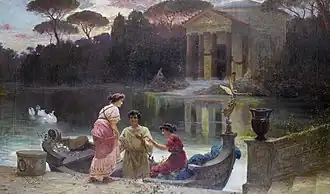 Evening at the temple
Evening at the temple -
 Feast of Centaurs
Feast of Centaurs -
 Rug Merchant in Ancient Rome
Rug Merchant in Ancient Rome -
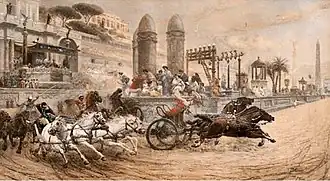 Chariots racing in the Circus Maximus
Chariots racing in the Circus Maximus -
 Pompeii Street Scene
Pompeii Street Scene -
 The Bath (?)
The Bath (?) -
.jpg) The Carpet Seller (1)
The Carpet Seller (1) -
.jpg) The Carpet Seller (2)
The Carpet Seller (2) -
.jpg) The Carpet seller (3)
The Carpet seller (3) -
.jpg) The Carpet seller (4)
The Carpet seller (4) -
.jpg) The Carpet Seller (5)
The Carpet Seller (5) -
 Chariot Racing
Chariot Racing -
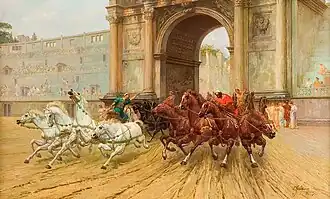 Racing Chariots Entering The Circus Maximus
Racing Chariots Entering The Circus Maximus -
 Road to Pompeii
Road to Pompeii -
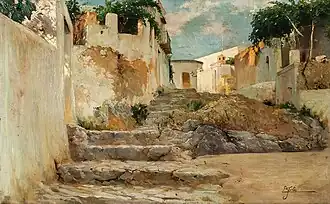 Steps(?)
Steps(?) -
 The Harpist(?)
The Harpist(?) -
 In A Jewelry Store
In A Jewelry Store -
 Detail from a Pompeii Love Song
Detail from a Pompeii Love Song -
 In A Jewelry Store
In A Jewelry Store -
 Pompeii Street
Pompeii Street -
 Art Seller
Art Seller -
 Fruit Vendor
Fruit Vendor -
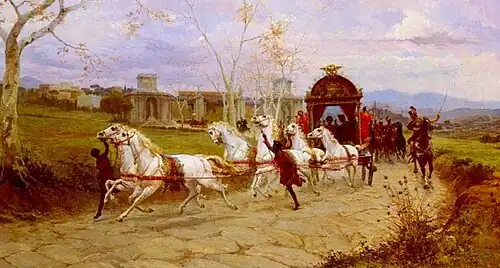 Hadrian returns from Tivoli
Hadrian returns from Tivoli -
 In the Roman Palace
In the Roman Palace -
 Inside A Roman Villa
Inside A Roman Villa -
 Pompeii Love Song
Pompeii Love Song -
 The Bedchamber(?)
The Bedchamber(?) -
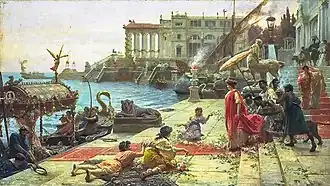 The Embarkment of a Roman Queen
The Embarkment of a Roman Queen -
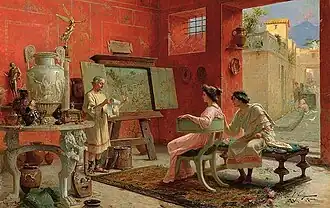 The Art Seller
The Art Seller -
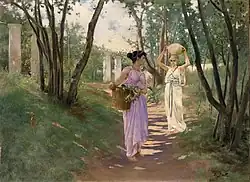 Burdens(?)
Burdens(?) -
 Festival
Festival -
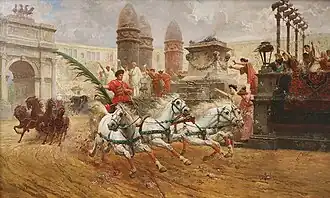 Greeting The Victor
Greeting The Victor -
 Rug Merchants
Rug Merchants -
 The Musicians
The Musicians -
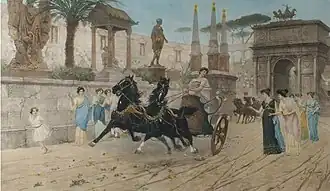 Victory
Victory -
 Arrival of Caesar
Arrival of Caesar -
 At the Antiquarian's
At the Antiquarian's -
 The Vendor of Antiquities
The Vendor of Antiquities -
 Quadriga on the Road to Pompeii(?)
Quadriga on the Road to Pompeii(?) -
.jpg) The Carpet Seller (6)
The Carpet Seller (6) -
 Roman Street Scene
Roman Street Scene -
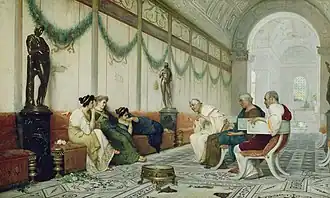 Interior of a Roman Building with Figures
Interior of a Roman Building with Figures
References
- ^ Getty Museum, Interior of Roman Building with Figures.
- ^ Istituto Matteucci, short biography.